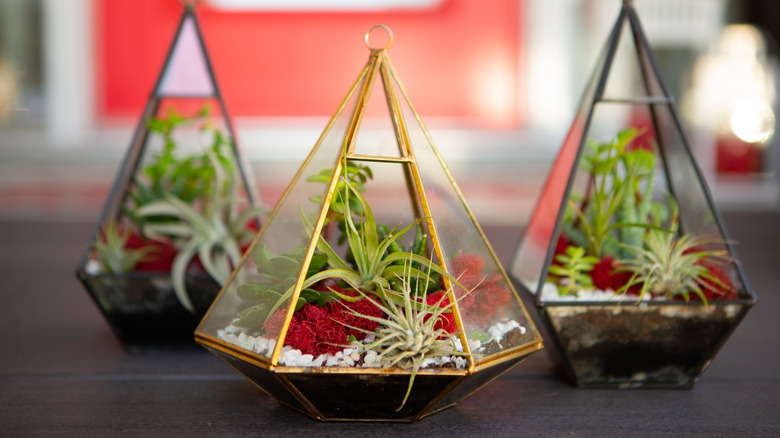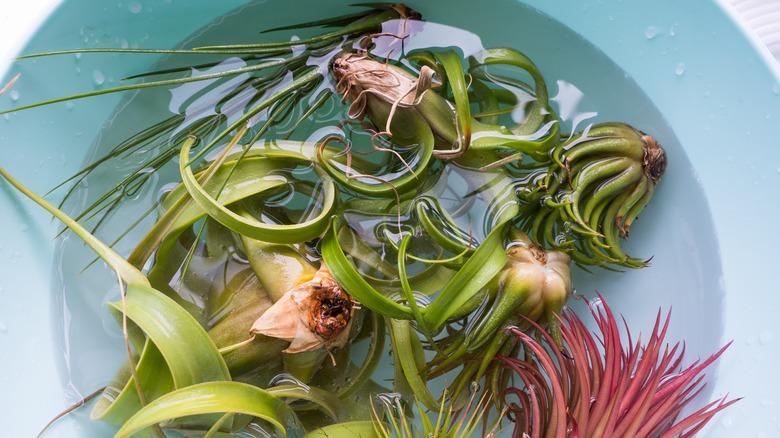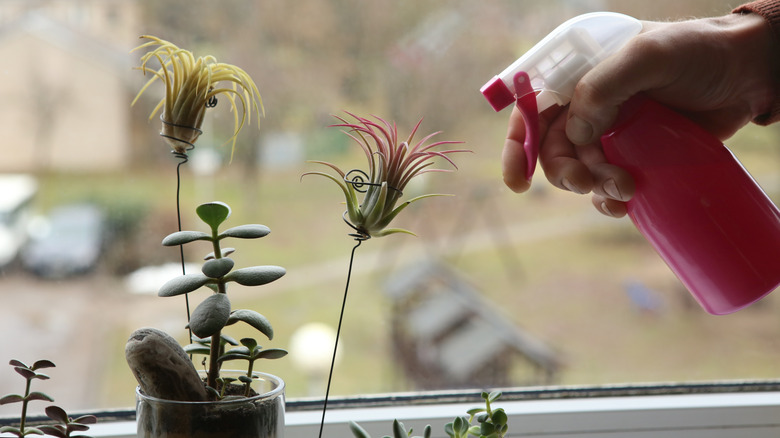Yes, Air Plants Need Water. Here's How To Hydrate Them For Successful Growing
We're generally taught that plants need soil, sunlight, and water to thrive, but then along comes the Tillandsia defying all odds. These tropical plants hail from North and South America and are known colloquially as air plants. Shockingly, they don't need any soil to grow. It's amazing! They can literally thrive in the palm of your hand. But that makes it easy to forget that while your air plants don't necessarily require moist, well-drained soil, they still need water. Fortunately, it's easy to care for your air plants and give them the hydration they require through frequent soaking or misting.
In their native tropical environment, air plants thrive off the moisture in the atmosphere. And unless your home doubles as a greenhouse, chances are you'll need to water your air plants consistently to help recreate their ideal humidity preference. The cells on their leaves, called trichomes, absorb the water they need to survive. So, instead of watering the roots like you would with normal plants, the focus is on their foliage instead. Fortunately, with the right amount of misting and soaking, your air plants should flourish.
Mist and soak your air plants regularly
Air plants are a little picky about their water. Pond or rainwater is the best drink to give them because the fluorine and chlorine in tap water can turn the leaf tips brown. If you are using tap water, let it sit overnight to reduce its chlorine content. For homes that are warm and well-lit, you'll need to submerge your air plants in room temperature water for 20 to 30 minutes once a week, whereas plants in cooler and darker areas should be fine with a soak every other week. After the air plants receive their bath, gently shake off any excess water and lay them upside down on a cloth or paper towel to dry. This is an important step because, if the foliage does not dry completely, your air plant could end up rotting.
Another way to give air plants their dose of water is with misting. Simply fill a spray bottle with room-temperature water and mist the leaves until the foliage is dripping wet. You'll need to do this every two days to hydrate your plants fully, but always ensure they dry completely before you spray them again. However, depending on the kind of air plant you have, misting may not be enough. This method is suitable for Tillandsias from arid areas, but varieties found in rainforests need to be soaked. While hydration is important for air plants, you should also be careful not to overwater them as that can be a death sentence.
Signs your air plant needs water (or has had too much)
If you notice signs of overwatering, sadly, your air plant is probably too far gone to save. Mushy roots, black bases, yellowing leaves, and shedding foliage are all tell-tale signifiers that your Tillandsias has had a bit too much to drink. This can be from soaking them for too long, misting them too frequently, or not letting them thoroughly dry out between waterings. Air plants can tolerate seasons of drought, so it's better to water them infrequently and increase if necessary rather than flooding them with a near-constant supply of H2O.
Your air plant turning brown and crispy could also be a sign of dehydration. But before things get that extreme, the leaves will curl back, soften, or lose their vibrant color to indicate that they're thirsty. When you water your air plant, the leaves should plump up and feel stiffer. So check the leaves to feel how full they are if you're unsure whether or not your Tillandsias needs a drink. Simply put, listening to your air plants is the best way to give them the care they need.


